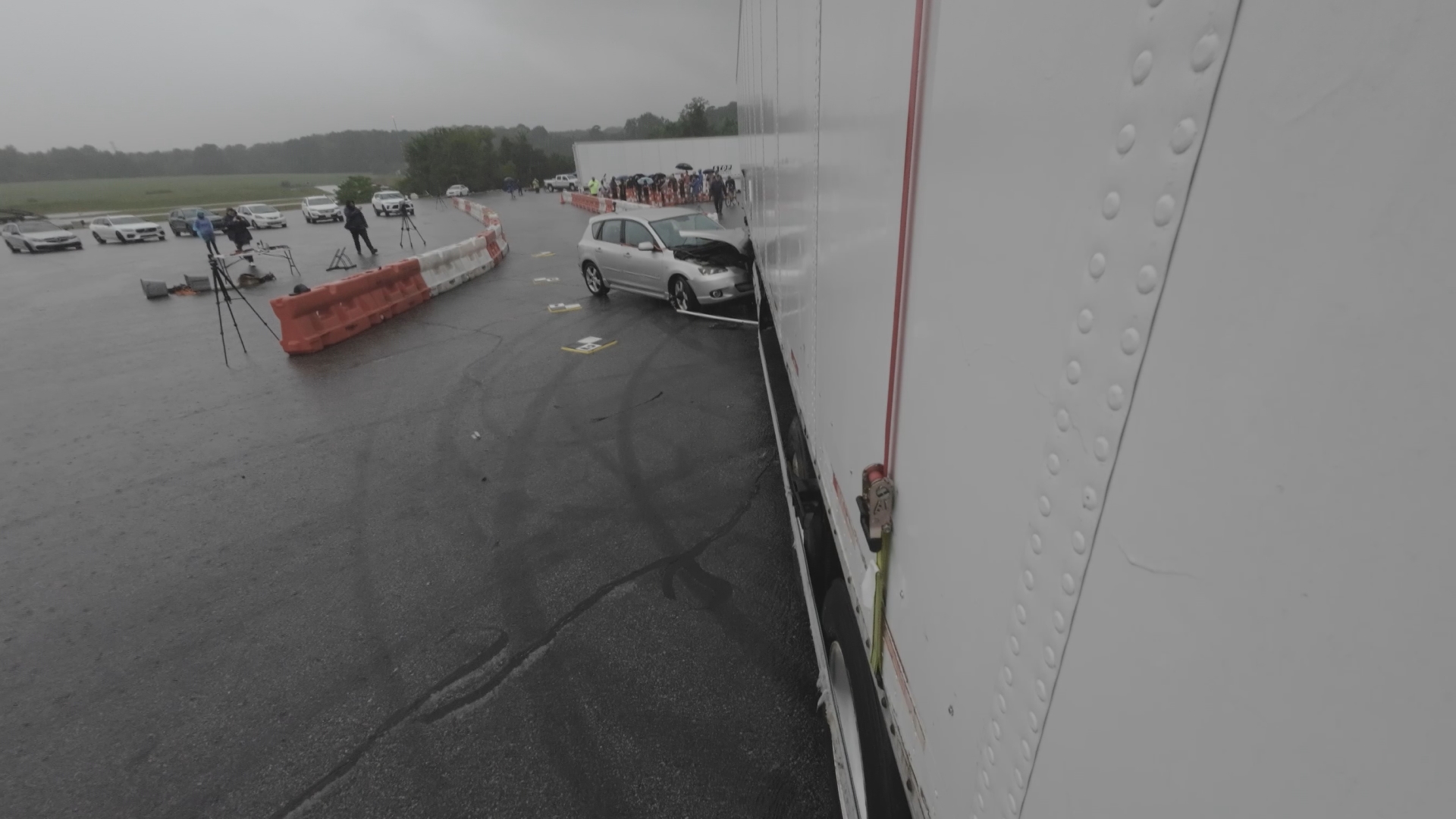Risky Rigs: Thousands of people have died after their car slid under a tractor-trailer
Advocates say that number is even greater, but states like Florida don’t track underrides properly.
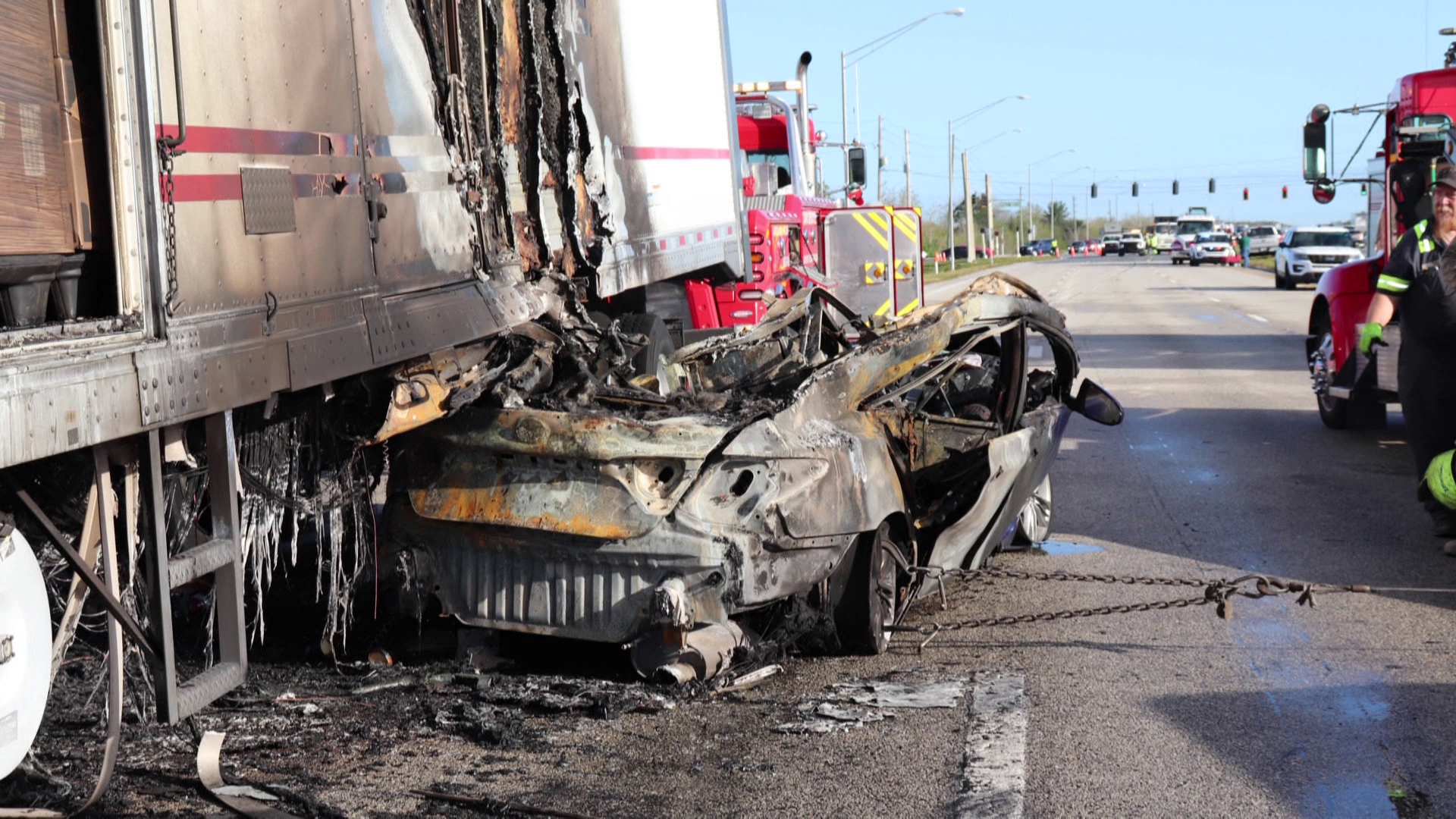
Every day you likely share the road with a semi-truck, a drive that can put you at risk for a type of accident that occurs nearly every day across the country but is something you may not have heard about until now.
It's called an underride.
Advocates say there's technology out there that could keep you safe, but others argue this type of accident doesn't happen enough to make the investment.
10 Investigates spent nearly a year looking into crash reports that led us to a loophole.
What is an underride crash? 'Unfortunately, most of those crashes are fatal or involve catastrophic injury'
Sitting down at their kitchen table in Harmony, Florida, Dahlia Diaz and her son David never thought they’d be talking about underride accidents. A type of accident they had never heard about until last year when Dahlia’s other son Raymond was in a crash.
“I remember getting dressed and proceeding to drive to where my son was. When I got there, they already [were] detouring people. My husband happened to be one of those people that was diverted to another area to continue to go,” Dalia Diaz said.
“So he didn’t even know that Raymond was there. When I pulled my car to the side, the officer told me that I had to leave," she continued. "I actually extended my phone, and I said, ‘No, my son is here.’ And the first thing that I heard him say was, ‘We have the mom.’ That’s when he told me, ‘I’m sorry, but your son didn’t make it.'”
According to the crash report, on the morning of Nov. 21, 2023, a semi-truck attempted to make a U-turn and blocked the path of 28-year-old Raymond Diaz’s car, sending it underneath the tractor-trailer.
“He was a loving, caring, unconditional person that you can never do wrong in his eyes,” Dalia said.
“He’s just an amazing person," David said. "There's not enough words to describe or enough time to dedicate to him. You know, I would be here all day for the rest of my life explaining to you guys how amazing my brother was."


Raymond Diaz died in an underride crash.
An underride is when a passenger car or motorcycle ends up underneath a tractor-trailer either on the back or the side.
“Unfortunately, most of those crashes are fatal or involve catastrophic injury,” said Joe Camerlengo of the Truck Accident Law Firm, who knows all too well about underride crashes. “It literally destroys the vehicle, and unfortunately, the occupants in the vehicle.”
He also realizes these crashes are highly underreported.
“For instance, in Florida, there's almost none unless the officer writes side underride. It's not counted by NHTSA and by the various organizations that are tracking these statistics,” Camerlengo said.
Discrepancies in tracking underride crashes The data doesn't tell the whole story
We requested underride crash data from the National Highway Traffic Safety Administration or NHTSA.
It shows nationally from 2008-2022, more than 3,300 people died from an underride crash. In Florida, during that time period, 97 people died.
But 10 Investigates has uncovered that data doesn’t tell the whole story.
We spent the past year collecting crash reports from the state, going over media stories, and analyzing hundreds of photos of underride crashes.

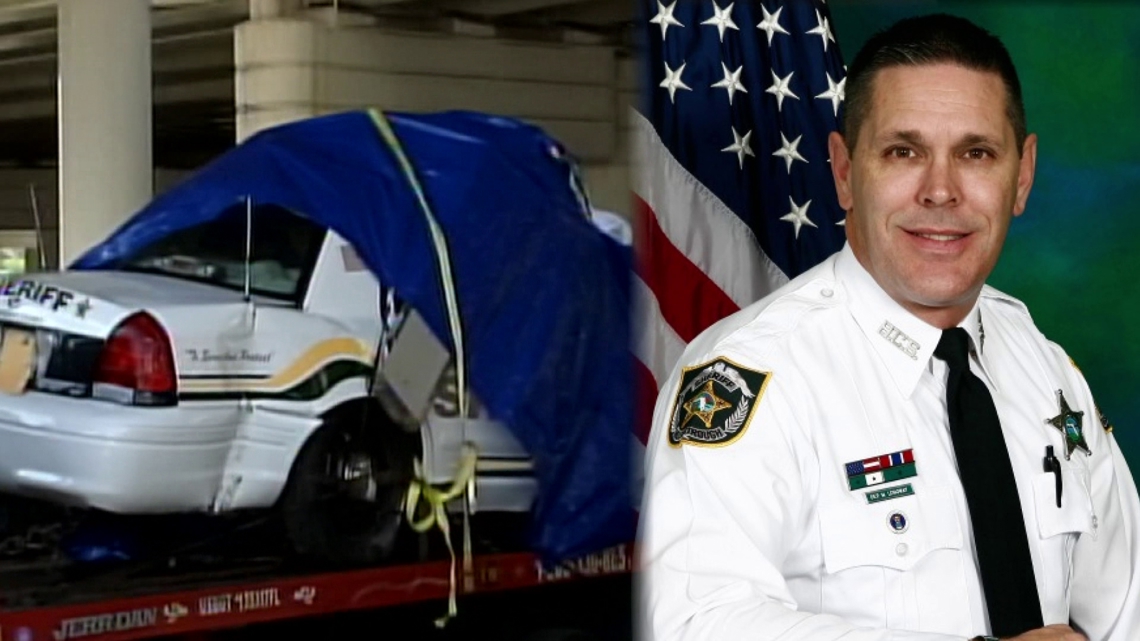
Crashes like one in 2013 that killed Hillsborough County Deputy Mark Longway. He was going just 35 miles an hour when his patrol car went underneath a tractor-trailer.

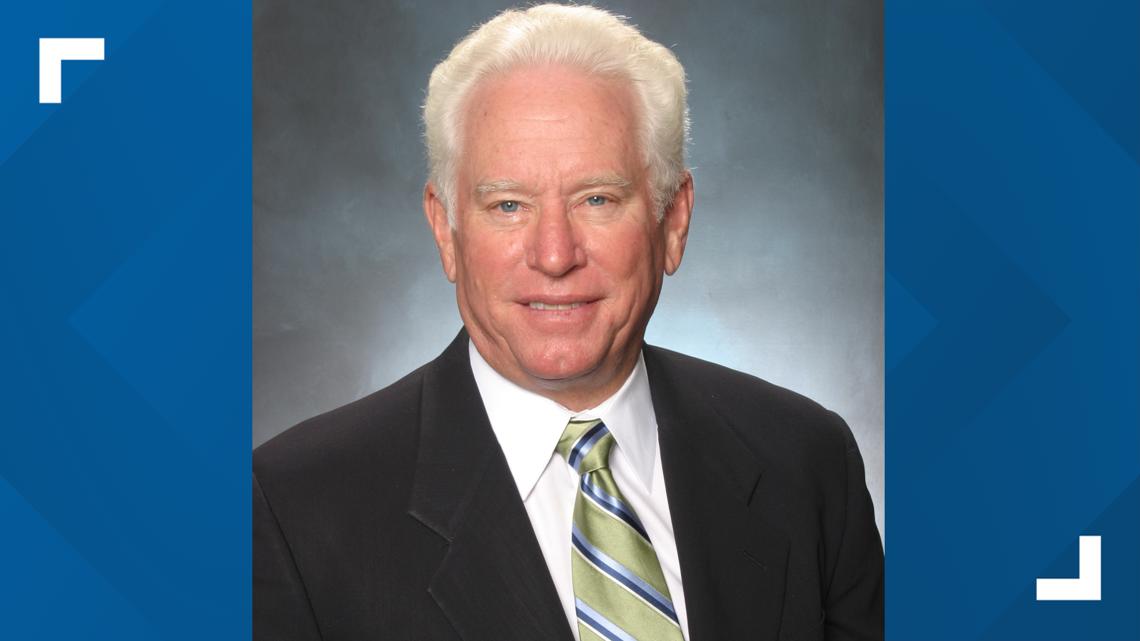
Tampa Bay Rays minority owner Lance Ringhaver was killed in 2016 in an underride crash.
There was a case seven years ago where a full-size pickup even went under a tractor-trailer.
“This is the crash report we talked about that was a side underride," Camerlengo said. "And then the description of the crash, manner of collision. It says angle. So we looked at the FARS report for 2017 this was not included in the side underride status, even though this is a clear side and ride fatality."
That’s what 10 Investigates has uncovered. Some of these underride crashes are not included in NHTSA’s reporting. NHTSA denied our request for an interview, but in a statement told us, “that their data comes from an analyst’s review of information in the Fatality Analysis Reporting System also known as FARS."
An NHTSA spokesperson said, “A crash won’t be marked as an underride unless a crash report has one noted or a police officer wrote in the description the word “underride” or photos included in a police report show an underride” which NHTSA admits that typically doesn’t happen.
We put together a database of crashes in Florida, where an underride occurred, but it’s never mentioned on the crash report.
In Raymond Diaz’s crash, the report only says the word “underneath” not “underride.”
The push for change 'You can't put a price on someone's life. You can't.'
Some states across the country have a section on their reports where an investigator marks whether the crash was an underride. The state of Florida doesn’t have that option. It’s one of 33 states that don’t.

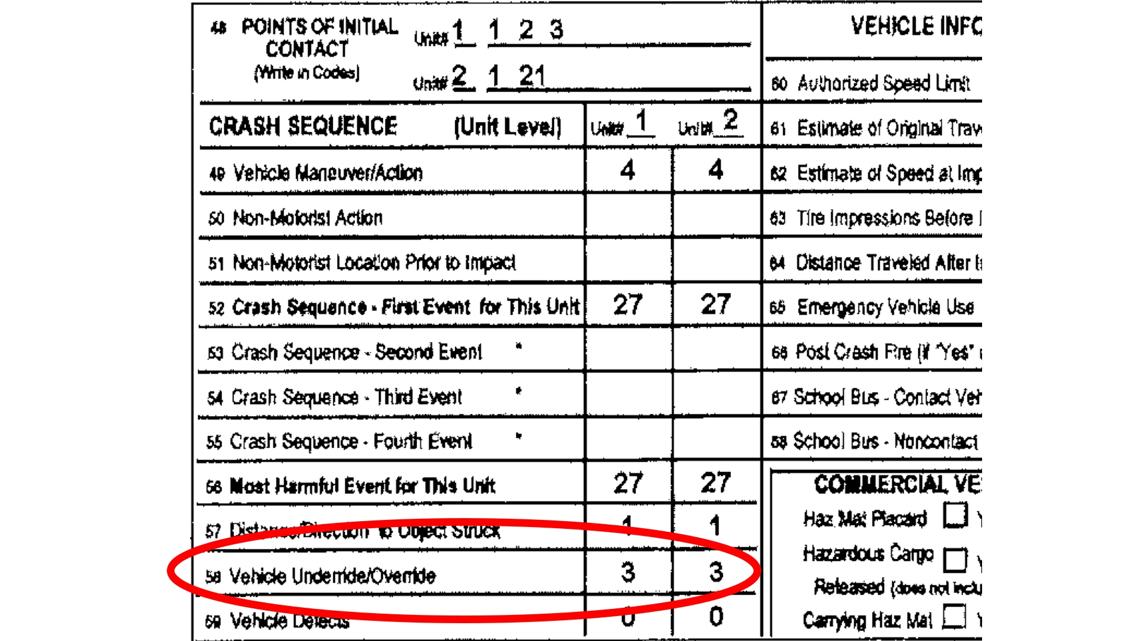
A Government Accountability Office report calls out the reporting of underride crashes noting these fatalities are likely underreported due to variability in state and local data collection.
“In fact, when we saw its fatality analysis reporting system for our crash report in Georgia in 2013, it reports at the rear of trucks, one underride death, and I know I had two daughters,” said Marianne Karth, whose daughters were killed in an underride accident. “So even just in our case, I know that it's undercounted so that the, the skewed cost-benefit analysis has been an obstacle.”
Marianne Karth was in the car when her two daughters were killed in an underride crash. Since her daughters’ deaths, Marianne has worked tirelessly to push for more regulations and safer technology on trucks to prevent underrides from happening, but she says there’s pushback about the number of accidents and questions over whether this is happening enough.
“When the rulemaking has taken place, then NHTSA does a cost-benefit analysis and because these deaths are undercounted, then, when you do that formula, the cost per life saved looks like it's greater than it actually would be because they don't have, they aren't counting to all of the deaths.”
Deaths like Raymond Diaz.
“You can't put a price on someone's life. You can't. I will never see my son again. And I would do anything in this world to see my son again. If you can change back time, I would definitely make sure my son doesn't walk out that door. But of course, that's just in the movies, right? It can't happen in your life, but we know what can happen? We can get together and we can demand that these changes are made,” Diaz said.
Side underride guards: Technology to help save lives Engineers say they have solved the problem. So why isn’t this technology required?
Marianne Karth was driving on a Georgia highway when her car slid underneath a tractor-trailer. Her son was in the passenger seat and her two daughters were in the back.
”There’d been a crash a few hours earlier and I slowed down. The truck driver did not. He hit our car, and it spun us around so that we ended up going backward into the back of another tractor-trailer and the rear underride guard on the back of that truck came right off the back of our car,” Karth said.
Her 17-year-old daughter Annaleah died instantly. Mary, Karth's 13-year-old, died a few days later.
“If, if we had hit the car straight on, I probably wouldn't even be here today," she said. "But in the aftermath wondering why my daughters had died and I did not, I learned all about underrides and that hundreds of people die every year from going under trucks and engineers can actually solve the problem.”
It’s why on a rainy day, Marianne is at a North Carolina training facility. Engineers say they have solved the problem.
“I realized minor crashes could be catastrophic from an underride,” said Aaron Kiefer, engineer and developer of the safety skirt. “I thought there has to be something out there that can prevent underrides and found out there really is not.”
Eleven years after Marianne’s loss, she’s watching this crash test.
“Ohhhhh yes! It didn’t pass the windshield did you see that!” Karth said.
Aaron Kiefer is testing his invention, the safety skirt. It goes on the side of a truck and can stop a car going 35 miles an hour.
“As far as I can see windshield [is] not broken at all,” Kiefer said while looking at the aftermath of the test.
So then why isn’t this technology required?
“Really, it’s a bottom-line industry and every dollar counts and every pound counts. It’s a dollar and cents and cost issues,” Kiefer said.
The skirt he says costs approximately $1,000 to build.
“But that’s building one with a custom manufacturer,” Kiefer said. “If you make it on a scale talking about 1/10th of that price.”
Something else 10 Investigates has uncovered, the NHTSA said in this report to Congress, that side underrides would save lives. The report states at speeds up to 40 mph, side guards would save 17 lives a year. It goes on to say though, the net benefits would be negative $1 billion for a side underride guard requirement on every trailer.
While NHTSA denied our request for an interview, we asked them by email whether the agency would like to see side underride technology on all tractor-trailers. They replied: “NHTSA is considering all available approaches to address underride crashes.”
We also took the NHTSA report to the Truckload Carriers Association, a national trucking organization that has pushed back on adding side underride guards.
“The reality is, is, if you look at the crash prevention, which would be, which for automatic emergency braking, it would reduce over almost 6000 crashes. So, it's a reduction in crashes. It's a prevention. And crashes is what our industry is looking to do not actually put devices on the trucks that will mitigate the crashes.” said David Heller, with the Truckload Carriers Association.
But Karth says an Insurance Institute for Highway Safety review that shows Automatic Emergency Braking systems may not work optimally to detect and avoid the side of trailers.
“When you learn that they're continuing to not solve the problem, it's just makes it very hard to, to get to peace with, with, you know, what you have to live with and to know that people are continuing to die because of that,” said Karth.
The American Trucking Association also sent us this statement regarding making underride guards mandatory:
“The trucking industry proactively invests $14 billion annually in safety training, technology, and other measures that extend beyond those required by law. Today's trucks are equipped with advanced safety features like automatic emergency braking, lane departure warning systems, forward-collision and blind-spot warnings, to name but a few. The American Trucking Associations actively supports a range of solutions to reduce, mitigate, and prevent crashes of all types – including underride-related crashes – involving all types of road users and is engaged in federal and state-level efforts to drive these solutions forward.
ATA believes equipment mandates should be based on sound engineering while considering real-world operations and weighing unintended consequences. The federal government’s own analysis cites significant, unresolved challenges posed by side underride guards, such as railroad crossings and other infrastructure designs that could ensnare this equipment and create an even greater safety hazard. Moreover, NHTSA concluded its proposal to require guards on new trailers would have a net-negative benefit of $1 billion, which pales in comparison to the $35 billion it would cost to install these guards on all existing trailers. This inordinate, unfunded mandate would kill current investments in innovative, lifesaving technologies that prevent crashes from occurring in the first place by forcing companies to use divert limited resources to less-effective, costly underride equipment.
ATA has remained engaged in conversations at the federal level regarding appropriate measures to mitigate and prevent side underride crashes through direct participation in and representation on NHTSA’s Advisory Committee on Underride Protection (ACUP), created under the 2021 Infrastructure Investment and Jobs Act. Additionally, we support DOT taking a more comprehensive approach on a crash-prevention strategy, including the deployment of advanced safety technologies and enforcement to prevent distracted and aggressive driving, which, in 2020, contributed to more than 3,142 deaths and an estimated additional 324,652 injuries, according to NHTSA.”



